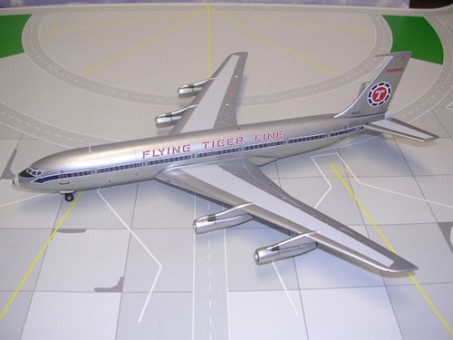You have no items in your shopping cart.
Details
Flying Tiger Line N322F B707-300
288 pcs made
The final design approved by Boeing for their new jetliner and was the 80th variant to be submitted; the Boeing 367-80, publicly known as the 707, was rolled out at Renton, WA plant on the 14th May 1954 in a canary yellow/chocolate/white and yellow color , with the registration N70700 to show its new Model number and had the Boeing constructors number 17158. The 367-80 underwent a series of taxi trials and then history was made on the 15th of July 1954, when the Boeing chief test pilot Alvin 'Tex' Johnson lifted the 367-80 off the ground for the first time. With the development of the airframe, Boeing adopted the 707 in 1964 while on trials, which included NASA.
The InFlight 200 707 features rubber tires, rolling wheels and a high attention to detail. At present, the 707 featured is the -320B/C series, with a potential of others being added to the range at a later date.
All Metal
Additional Info
-
Stock#IF70010
-
BrandInFlight Models
-
Country of Manufacture
-
AircraftBoeing B707
-
AirlineFlying Tigers
-
RegistrationN322F
-
MaterialN/A
-
Scale1:200
-
Dimensions (L x W)9.17 x 8.54 inches / 23.30 x 21.70 cm
Warning: Choking Hazard!
Contains small parts. Not a toy. Not for children under 3 years.
Customer Reviews
- Flying Tiger Line N322F B707-300
-
This B707-300 is configured with both passenger and cargo service with a big cargo door on the left side of the aircraft. Antenna and lights show up nicely on the top of the fuselage and undercarriage. Unlike some of the earliest Inflight B707's this one sits flat on the display and is not tail heavy. This aircraft was used in 1965 to take 35 scientists and equipment to the South Pole. From a report about this trip: "The flight holds several records including the
first transpolar round-the-world flight. It was organized and piloted by Fred Austin, who then was a chief pilot for TWA. The aircraft was the Boeing 707-349C #N322F with 35 on board including 5 pilots, scientists studying the atmosphere, and the first test prototype of Litton's inertial navigation system (which worked perfectly). One of the pilots was Bernt Balchen, who had piloted Byrd's flight over Pole in 1929. Balchen was at the controls when this flight pased over Pole (whichwas plainly visible). He looped around the station several times. The aircraft carried 2 2000-gallon bladders in the main fuselage for extra fuel storage; these sloshed around alarmingly during takeoffs. The flight route was Honolulu/London/Lisbon/BA/ChC/Honolulu, 15-17 November, 1965." Personally I like to praise IF for picking a aircraft that also includes a "history" such as flying over the South Pole. After its work for Flying Tiger Airlines the aircraft also flew in Caledonian Airways colors, British Caledonian Airways and TAAG Angola Airlines (Posted on 8/10/2010)

